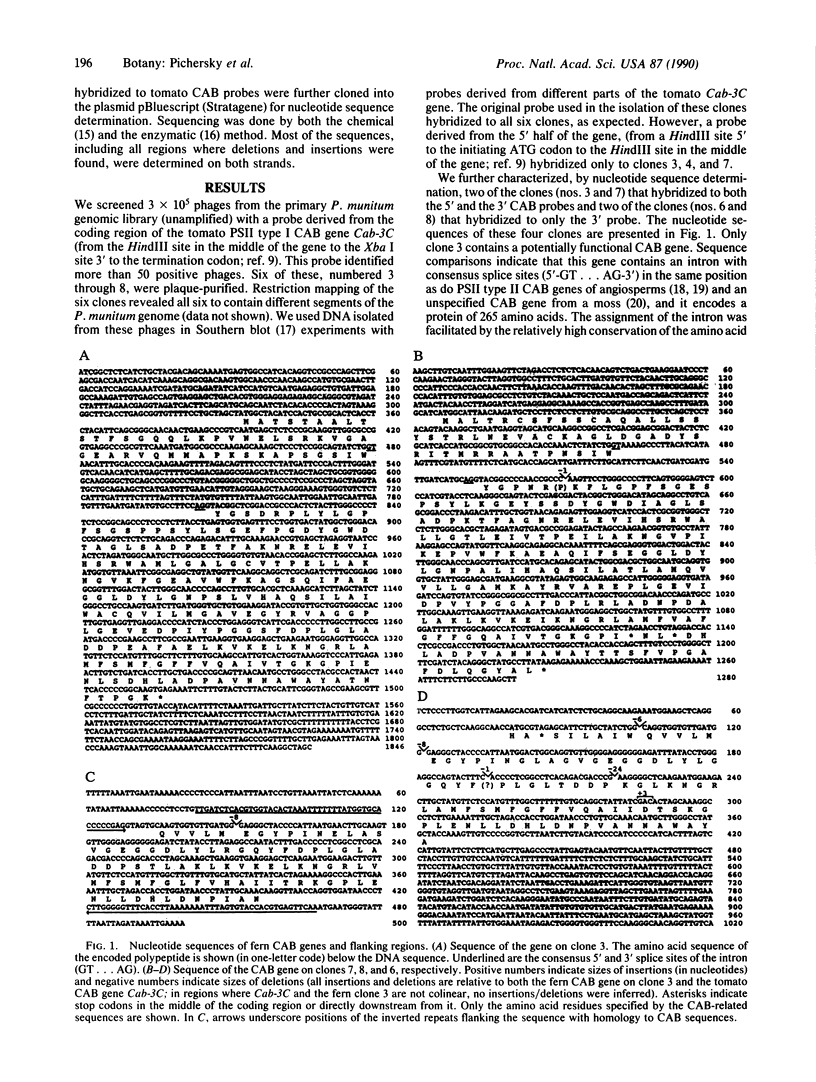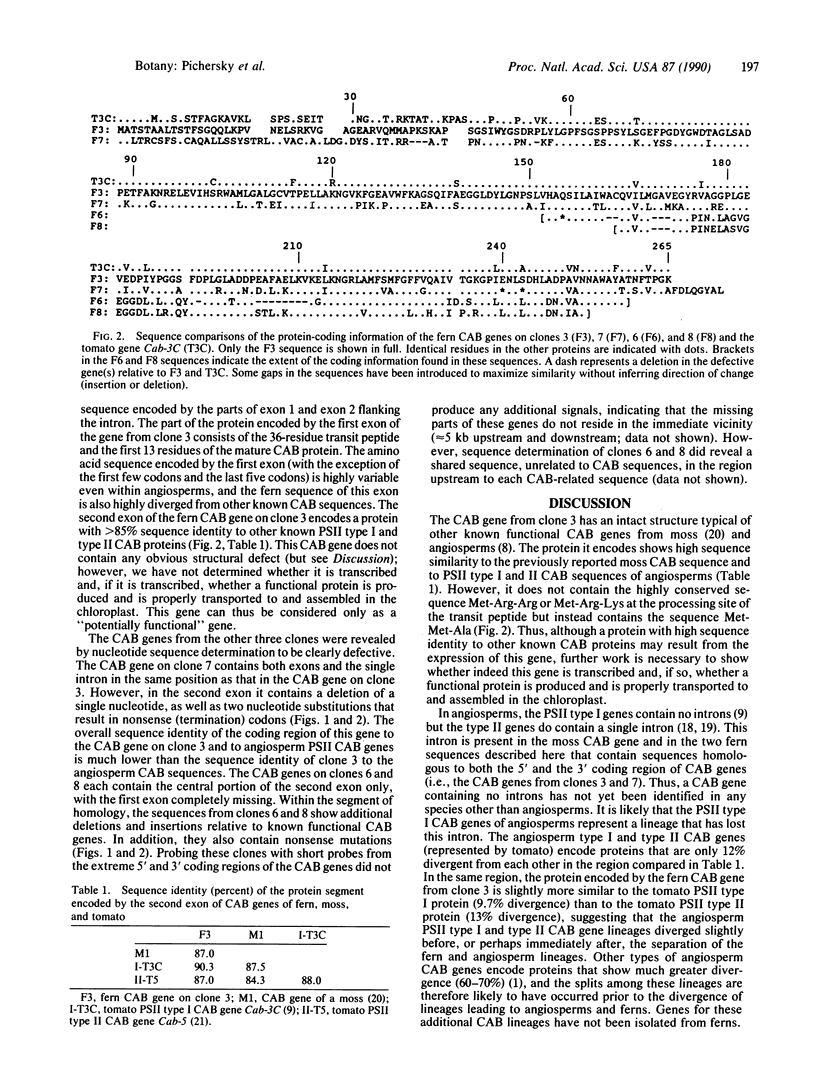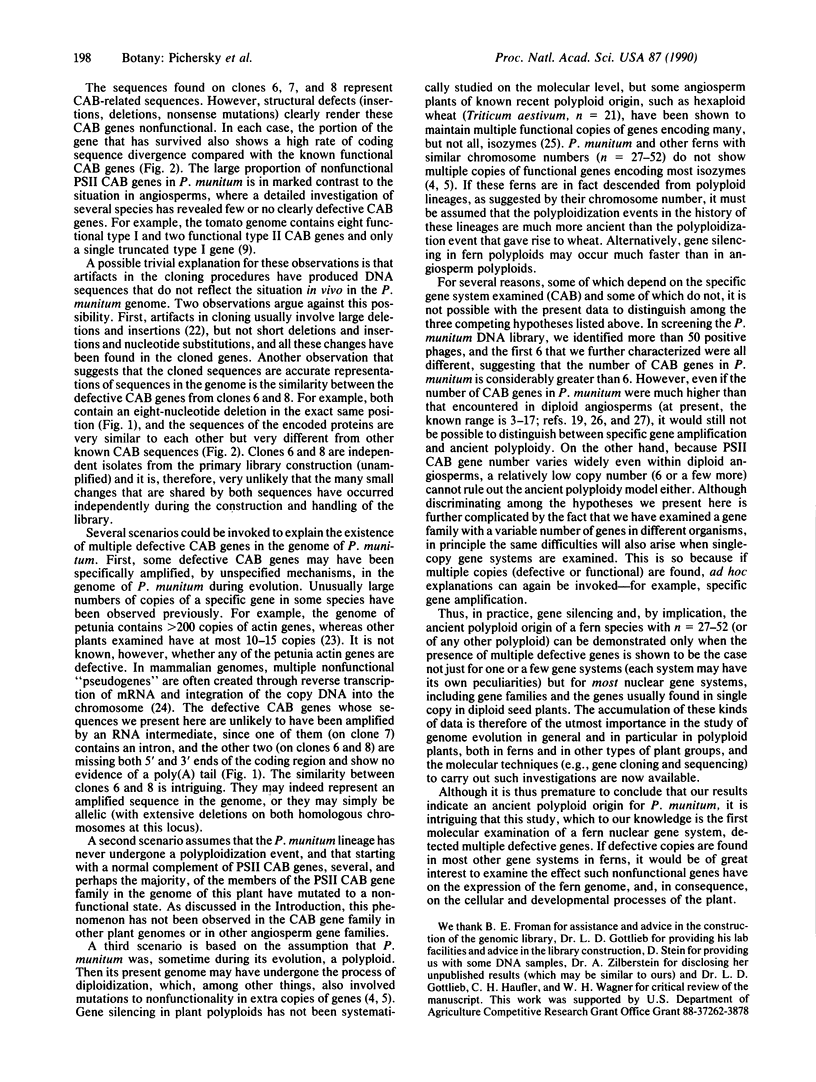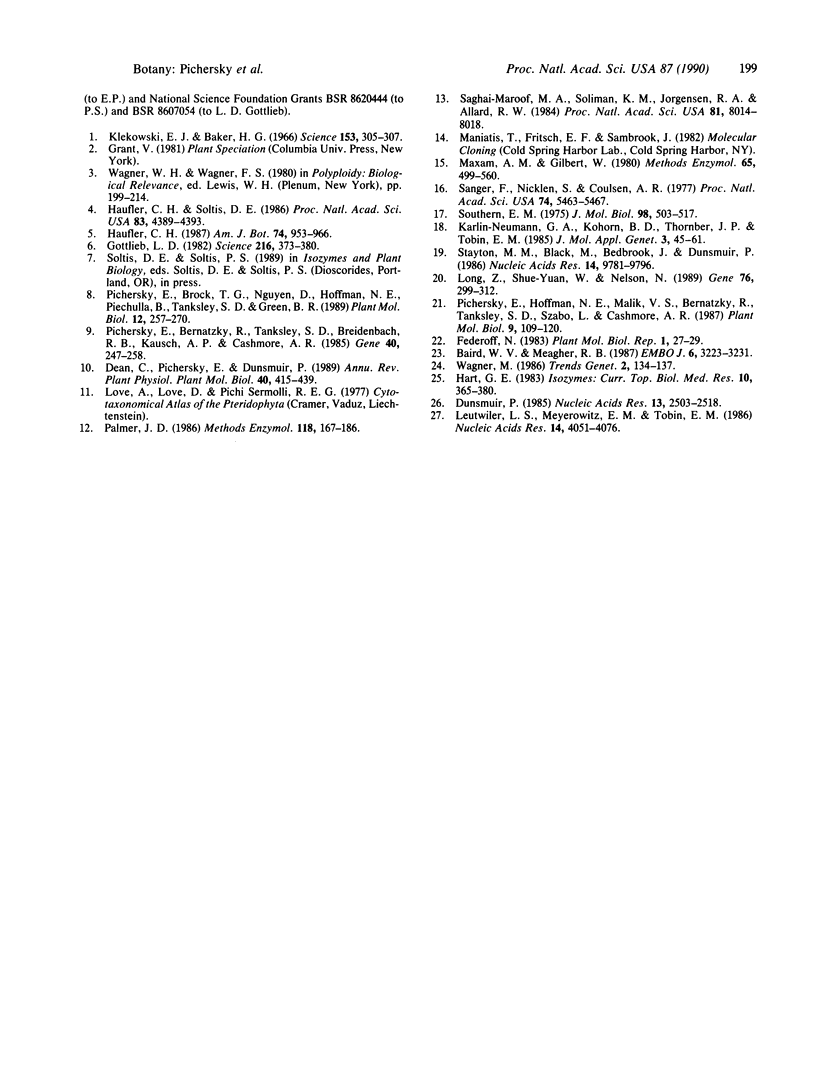Abstract
The majority of homosporous ferns have a chromosome number that is severalfold greater than that of diploid seed plants. These fern species have therefore been generally considered to be of polyploid origin. Enzyme electrophoretic investigations have demonstrated, however, that within fern genera, species having the lowest chromosome numbers (n = 27-52) have the number of isozymes typical of diploid seed plants; there is no isozyme evidence for polyploidy of these plants. We have constructed a genomic DNA library from Polystichum munitum (n = 41), a homosporous fern, and have screened the library for sequences homologous to the chlorophyll a/b-binding (CAB) protein genes of higher plants. The majority of the sequences isolated and characterized by nucleotide sequence determination represent defective CAB genes. This result is in contrast to the situation in the genomes of diploid angiosperms, where most, and sometimes all, copies of the CAB gene family represent functional members. Several hypotheses could explain the existence of multiple defective CAB genes in P. munitum. (i) The defective CAB genes are the result of "gene silencing" following polyploidy. (ii) P. munitum has not gone through a polyploidization event, but several, and perhaps the majority, of its CAB genes have mutated to a nonfunctional state (a phenomenon not yet observed in any of the genomes of non-fern plants so far examined). (iii) Some defective CAB genes have been specifically amplified in the genome of P. munitum.
Full text
PDF




Selected References
These references are in PubMed. This may not be the complete list of references from this article.
- Baird W. V., Meagher R. B. A complex gene superfamily encodes actin in petunia. EMBO J. 1987 Nov;6(11):3223–3231. doi: 10.1002/j.1460-2075.1987.tb02639.x. [DOI] [PMC free article] [PubMed] [Google Scholar]
- Dunsmuir P. The petunia chlorophyll a/b binding protein genes: a comparison of Cab genes from different gene families. Nucleic Acids Res. 1985 Apr 11;13(7):2503–2518. doi: 10.1093/nar/13.7.2503. [DOI] [PMC free article] [PubMed] [Google Scholar]
- Gottlieb L. D. Conservation and duplication of isozymes in plants. Science. 1982 Apr 23;216(4544):373–380. doi: 10.1126/science.216.4544.373. [DOI] [PubMed] [Google Scholar]
- Hart G. E. Genetics and evolution of multilocus isozymes in hexaploid wheat. Isozymes Curr Top Biol Med Res. 1983;10:365–380. [PubMed] [Google Scholar]
- Haufler C. H., Soltis D. E. Genetic evidence suggests that homosporous ferns with high chromosome numbers are diploid. Proc Natl Acad Sci U S A. 1986 Jun;83(12):4389–4393. doi: 10.1073/pnas.83.12.4389. [DOI] [PMC free article] [PubMed] [Google Scholar]
- Karlin-Neumann G. A., Kohorn B. D., Thornber J. P., Tobin E. M. A chlorophyll a/b-protein encoded by a gene containing an intron with characteristics of a transposable element. J Mol Appl Genet. 1985;3(1):45–61. [PubMed] [Google Scholar]
- Klekowski E. J., Jr, Baker H. G. Evolutionary significance of polyploidy in the pteridophyta. Science. 1966 Jul 15;153(3733):305–307. doi: 10.1126/science.153.3733.305. [DOI] [PubMed] [Google Scholar]
- Leutwiler L. S., Meyerowitz E. M., Tobin E. M. Structure and expression of three light-harvesting chlorophyll a/b-binding protein genes in Arabidopsis thaliana. Nucleic Acids Res. 1986 May 27;14(10):4051–4064. doi: 10.1093/nar/14.10.4051. [DOI] [PMC free article] [PubMed] [Google Scholar]
- Long Z. F., Wang S. Y., Nelson N. Cloning and nucleotide sequence analysis of genes coding for the major chlorophyll-binding protein of the moss Physcomitrella patens and the halotolerant alga Dunaliella salina. Gene. 1989;76(2):299–312. doi: 10.1016/0378-1119(89)90170-4. [DOI] [PubMed] [Google Scholar]
- Maxam A. M., Gilbert W. Sequencing end-labeled DNA with base-specific chemical cleavages. Methods Enzymol. 1980;65(1):499–560. doi: 10.1016/s0076-6879(80)65059-9. [DOI] [PubMed] [Google Scholar]
- Pichersky E., Bernatzky R., Tanksley S. D., Breidenbach R. B., Kausch A. P., Cashmore A. R. Molecular characterization and genetic mapping of two clusters of genes encoding chlorophyll a/b-binding proteins in Lycopersicon esculentum (tomato). Gene. 1985;40(2-3):247–258. doi: 10.1016/0378-1119(85)90047-2. [DOI] [PubMed] [Google Scholar]
- Saghai-Maroof M. A., Soliman K. M., Jorgensen R. A., Allard R. W. Ribosomal DNA spacer-length polymorphisms in barley: mendelian inheritance, chromosomal location, and population dynamics. Proc Natl Acad Sci U S A. 1984 Dec;81(24):8014–8018. doi: 10.1073/pnas.81.24.8014. [DOI] [PMC free article] [PubMed] [Google Scholar]
- Sanger F., Nicklen S., Coulson A. R. DNA sequencing with chain-terminating inhibitors. Proc Natl Acad Sci U S A. 1977 Dec;74(12):5463–5467. doi: 10.1073/pnas.74.12.5463. [DOI] [PMC free article] [PubMed] [Google Scholar]
- Southern E. M. Detection of specific sequences among DNA fragments separated by gel electrophoresis. J Mol Biol. 1975 Nov 5;98(3):503–517. doi: 10.1016/s0022-2836(75)80083-0. [DOI] [PubMed] [Google Scholar]
- Stayton M. M., Black M., Bedbrook J., Dunsmuir P. A novel chlorophyll a/b binding (Cab) protein gene from petunia which encodes the lower molecular weight Cab precursor protein. Nucleic Acids Res. 1986 Dec 22;14(24):9781–9796. doi: 10.1093/nar/14.24.9781. [DOI] [PMC free article] [PubMed] [Google Scholar]


